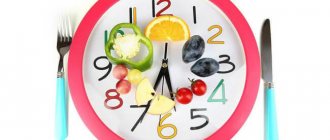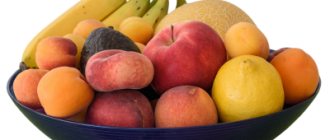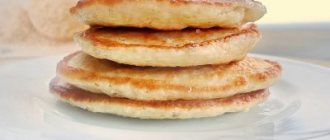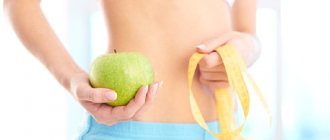A protein diet for athletes is as important as properly organized training sessions. A protein-based nutritional system helps you lose weight, build muscle mass, remove fat from tissues and organs, and achieve athletic results without harm to your health.
- We recommend reading: athlete nutrition to stay in shape
Dear readers, we invite you to SUBSCRIBE TO OUR NEW CHANNEL about weight loss and a healthy lifestyle. Useful materials will be published several times a week!
Protein and its importance
In sports nutrition, protein is the protein that makes up almost all body tissues. When protein is broken down in the body, energy is released.
There are two groups of protein - independent amino acids, which are vital, and interchangeable acids. Proteins from the first group are found in liver, fish, meat, dairy products, and from the second - in various types of cereals.
For the body to function normally, the daily protein intake per kilogram of a person’s own weight must be at least 1.5 grams. The ideal ratio is 2 grams.
Authorized Products
A protein diet for athletes includes:
- Soups with low-fat meat/fish broth.
- Chicken eggs (whites can be separated), prepared in any way.
- Lean varieties of red meat (lean varieties of beef, veal), chicken, turkey, rabbit.
- Bran/grain bread, grain bread.
- Seafood (shrimp, crabs, squid, mussels), sea and river (salmon, herring, pike, trout, hake, cod, tuna, sardines, perch).
- Low-fat or low-fat dairy/fermented milk products (milk, fermented baked milk, kefir, yogurt, cottage cheese), pickled cheeses.
- Wholemeal pasta. Porridge (wheat, buckwheat, oatmeal), brown rice.
- Legumes (beans, lentils, chickpeas, peas), soy and soy-based products (tofu cheese).
- Unrefined first (cold) pressed vegetable oils - olive, sesame, flaxseed, corn, fish oil, butter.
- Non-starchy vegetables (zucchini, onions, cucumbers, tomatoes, carrots, cabbage, bell peppers), garden herbs.
- Assorted nuts, seeds, sesame and flax seeds, wheat/rye bran, seaweed.
- Sour fruits/berries.
- Green tea with lemon, freshly squeezed juices, purified still water, herbal tea, rose hip decoction.
If a person who comes to the gym has a clear goal - to build muscle mass, a well-designed training program is not enough. It is necessary to approach the construction of the diet correctly. The menu should be dominated by protein foods, since protein is the main element necessary for building muscle.
Protein varieties
Protein supplements produced by sports nutrition manufacturers are of organic rather than chemical origin. They are obtained from natural products, when all unnecessary substances and components present in them are removed and come in several types:
Isolate
Protein in its purest form, the amount of impurities in which is minimal. It is easily absorbed by the body. This drug is the most expensive among whey proteins. It is taken after training to restore energy reserves and tone muscles.
Concentrate
The protein it contains is not subject to such deep purification. The ratio of impurities in it can range from twenty to sixty percent of the total mass of the product.
Hydrolyzate
The drug is not just purified, but partially fermented. Its main feature is instant digestibility. This is achieved due to the fact that each substance has the form of a peptide. The reduced load on the body leads to a decrease in the number of enzymes responsible for the process of protein breakdown, which results in energy production. This refers to a significant disadvantage of this category of protein.
Lack of proteins in sports nutrition
A lack of protein in an athlete’s diet entails a slowdown in muscle recovery and growth, can cause disruptions in the functioning of all body systems and cause serious harm to health. For athletes, protein deficiency is more dangerous than for people who lead a less active lifestyle, due to greater loads and greater intensity of metabolic processes.
Excessive amounts of protein in the diet is a specific problem, typical mainly for bodybuilders, for whom building muscle mass is one of the main tasks. Excess proteins lead to intoxication of the body with their breakdown products. This carries a risk of kidney disease.
Types of Protein Supplements
Protein is obtained from various substances. Depending on the donor, the following groups of drugs are distinguished:
Egg
The most valuable protein, serving as a standard for assessing the usefulness and effectiveness of other types. In the body it is absorbed almost completely, that is, almost one hundred percent.
Whey Protein Isolate
The most valuable supplement containing the maximum concentration of BCAA amino acids, which has the highest rate of breakdown. Thanks to this, the drug instantly restores muscle condition and energy reserves. This makes it ideal for taking in the morning, when the body has not yet fully recovered from sleep, and after training.
Casein
It has a complex structure. It is obtained as a result of the use of a special enzyme, which leads to curdling of milk. It has a special structure and, upon entering the body, is converted into cheese mass, which is absorbed over a long period of time. The gradual breakdown of casein protein allows the body to obtain energy for a long period. You can use it both at night and when you need energy replenishment for some time.
Soy
The unique acidic composition of this type of protein has a beneficial effect on the concentration of cholesterol levels. It falls into the category of supplements that promote effective weight loss. It is usually used by people suffering from excess weight, as well as athletes with individual lactose intolerance. The downside to this soy-derived protein is that it can cause gastrointestinal problems. When taking it, you must follow a strict dosage.
Collagen
Thanks to its amino acid composition, it strengthens ligaments, joints, skin, and connective tissues. The supplement is used as a complement to other main medications.
Lactic
It consists of a mixture of casein and whey proteins, which are usually taken in proportions of 20 to 80 percent, and a small amount of milk carbohydrates.
Each of the listed protein types can be purchased separately. Sports nutrition manufacturers offer complex supplements that contain two or more proteins.
What is protein and how to take it?
Protein diet. Queen of diets, or how to lose weight forever!
Even ladies who are far from dietary passions can recall more than a dozen different diets offhand: the diet of Larisa Dolina and Kim Protasov, Atkins and Bragg, fashion models and ballerinas, mono-diets on kefir, potato, cabbage, apple, buckwheat diet, lemon diet and even quite exotic ones like chocolate and alcoholic, popularly called the drunkards' diet. And oddly enough, all these methods, developed by someone and tested by many millions of women, seem to idealize the female figure to the world standards of the first half of the 20th century - 90-60-90.
Is a protein diet the best?
In fact, no matter how much the inquisitive female mind, which is in a hypothetical connection with logic, would like to diversify the path to a slim and beautiful figure, in nature there is only one diet that can lead to a reduction in fat and improve the structure of the body. This is the so-called protein diet, which is sometimes called the recommended diet for residents of central Russia, proposed by the Russian Academy of Medical Sciences.
So, let's look at the key points of losing weight.
1) Losing weight is a reduction in body volume and weight. Most often, during a diet aimed at losing weight, fat reserves and muscle tissue are lost.
The fact is that during a reduction in the intake of nutrients into the body, in our case proteins, fats and carbohydrates, it begins to burn through reserves to maintain vital functions. Glycogen from the liver and muscles is used first, then muscle and adipose tissue in equal volumes.
That is, for every 5 kg “lost” during a regular diet, 1.5 is due to intercellular and intracellular fluid, 1.5 to muscle mass and only 2 to pure fat reserves.
2) The speed of metabolic processes depends on the functioning of the hormonal apparatus and the amount of muscle mass in the body. It is muscles that consume up to 60% of all energy resources that come from food.
Accordingly, the lower the muscle mass, the fewer calories are needed for life, the more surplus remains after each meal, which, as you know, goes directly to the fat depot, to the tummy or buttocks.
On topic: Chinese diet for weight loss
3) Maintaining a constant mass of muscle fibers and at the same time losing fat reserves is possible only by ensuring that the body receives a high amount of amino acids, that is, plant and animal proteins.
4) This is why fasting, diets based on complex carbohydrates or a sharp reduction in calories, as well as any other nutritional principles, never lead to long-term results.
Important!
Yes, at first the result is obvious, so to speak, however, after a while the weight goes up again, because it is extremely difficult to constantly maintain a low calorie level. And any increase in it, even to the previous level of equilibrium, leads to an increase in fat. After all, now there are fewer muscles, which means the energy intake from food needs to be reduced.
You can stick to a protein diet all your life, the main thing is not to go to extremes and, if possible, find 3-4 hours a week to engage in any type of physical activity.
The main points of the queen of diets - the protein diet
1) Food should be supplied to the body in small portions 4-6 times a day. 2) Three to four meals should include protein: boiled or stewed lean beef, pork, lamb, fish, chicken, wild game and other animal proteins, eggs, cottage cheese, seafood.
3) Ideal side dishes for protein foods are raw and boiled vegetables, whole grains, durum pasta. 4) Fruits must be present in the diet and consumed before 17:00 in the evening. 5) Try to give up fatty sweets, and give preference to marshmallows, marmalade, meringue and marshmallows, in small quantities. 6) Drink more than 2 liters of regular water per day.
7) Eliminate smoked, fried, baked, deep-fried foods, as well as semi-finished products and fast food, mayonnaise from your diet!
In fact, the above principle of nutrition is just a normal diet for a person not engaged in heavy physical labor, however, in our time of pickles and fast food, it is precisely this natural and healthy nutrition that is dietary.
When following this protein diet, weight loss is usually between 3-5 kg per month.
Moreover, it is the fat and liquid that he “held” that goes away, but the muscles remain in place, and even if not at Stakhanov’s pace, you are transformed, and not into a “dead cow”, but into a “slender gazelle”!
Author's article by personal fitness trainer Vladlena Evstafieva
© 2010 - 2011, Fitness, diets and how to lose weight quickly on MySharm.ru. Author's article. Copying, including partial, and using materials from the author’s article for commercial purposes is strictly prohibited! The article is the property of the site mon-charme.ru All rights reserved.
—————————————————————————————————————————————
Source: https://mon-charme.ru/belkovaya-dieta.html
General recommendations for use
There are no supplements that are 100% protein. Its concentration varies between 50-90%. There are certain preparations in which protein makes up 95% of the total mass of the mixture. And in order to calculate the dosage and introduce the drug into your usual diet, you should take this fact into account and know how to take it correctly.
The additive is diluted with juice or water. The amount of liquid does not play any role. The only rule to remember when preparing a protein mixture is that you cannot use boiling water. Otherwise, the protein may simply coagulate, that is, become unsuitable for consumption.
To gain additional muscle mass, you need to take your daily protein supplement in two doses. The mixture is drunk the first time in the morning, and the second time - after training or before an evening meal, if it is a rest day. The amount of protein consumed can be divided into more meals. The main thing is not to drink the entire mixture at once. Otherwise, there is a high probability that the gastrointestinal tract will not be able to cope with such an amount of protein, some of which will not be absorbed.
When a protein mixture is consumed for the purpose of losing weight, it replaces part of the usual diet, but is not combined with usual meals. The supplement is used instead of snacks, breakfast or dinner. This approach allows you to replenish the protein required for the full functioning of the body, but reduce the calorie content of your usual diet. This will have a positive effect on weight in the direction of reduction.
Daily menu
A sports protein diet allows you to eat small meals up to ten times a day. Let's look at an example of a set of products that make up a menu for a week.
Breakfast:
- Peaches, curd products, tea;
- Toasted grain bread, garden berries, hard cheese, tea, honey;
- Protein shake, apple;
- Buckwheat porridge, boiled beef, pear, tea;
- Milk, diet bread, Lenten cookies;
- Fruit salad, low-fat yogurt;
- Oatmeal without milk with dried fruits;
- Kefir, dry cookies;
- Cottage cheese casserole, carrot salad.
Second breakfasts:
- Toasted grain bread, cheese;
- Muesli, kefir, wild berries;
- Nuts;
- Low-fat cheese and rye bread;
- Yogurt and dark chocolate;
Lunches:
- Grilled meat, millet porridge, vegetable salad, compote;
- Tomato soup, boiled veal, cabbage salad, tea;
- Stewed chicken breast, beet salad with cheese;
- Roasted pork tenderloin, apple and orange salad;
- Lentil soup, seafood salad;
- Brown rice, boiled chicken breast;
- Creamy spinach soup, steamed veal cutlets;
- Fish salad with vegetables.
Dinners:
- Grilled trout, vegetable salad, baked potatoes, tomato juice;
- Baked fish with green peas;
- Five egg white omelette with mushrooms;
- Baked trout, brown rice;
- Vinaigrette, bran bread;
- Stewed beans, lean boiled lamb;
- Cabbage salad, boiled chicken breast;
- Second dinners: fermented milk products.
Why do non-athletes need protein?
The use of protein mixtures has no age restrictions. It is obtained exclusively from food raw materials. It is well absorbed and physiologically compatible with the body. The high need for it is due to the lifestyle that modern people lead.
Stress, physical inactivity, and short-term physical activity helped reduce the need for carbohydrates and fats. However, given the vital importance of protein in providing energy to the body, the amount of protein required has remained unchanged.
This situation is not reflected in the food industry. The abundant fast food available contains a high concentration of fats and carbohydrates, but there is practically no protein in it. The result of this is protein starvation, which protein shakes are designed to counteract.
Possible harm from eating protein
A contraindication to the use of the supplement is individual intolerance to protein or another substance included in the mixture. Against the background of dysbacteriosis or a lack of protein-digesting enzymes, indigestion may occur. If a similar situation occurs, you should reduce the dosage of the mixture or start taking enzymes. This can happen even when an athlete purchases the best supplement.
Protein cannot cause any harm to internal organs, but can lead to an exacerbation of existing kidney diseases. To eliminate this consequence, it is enough to exclude the additive from your diet. This will allow the body to return to its original state.
Igor September 23, 2016











